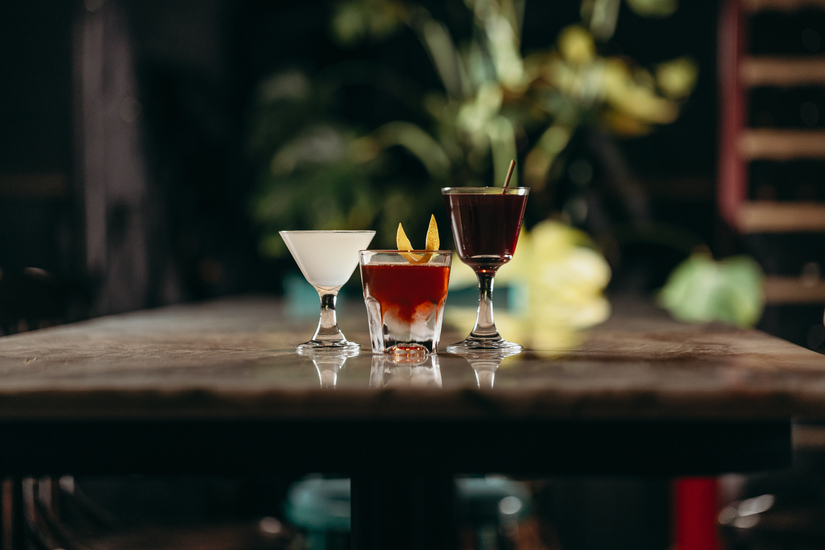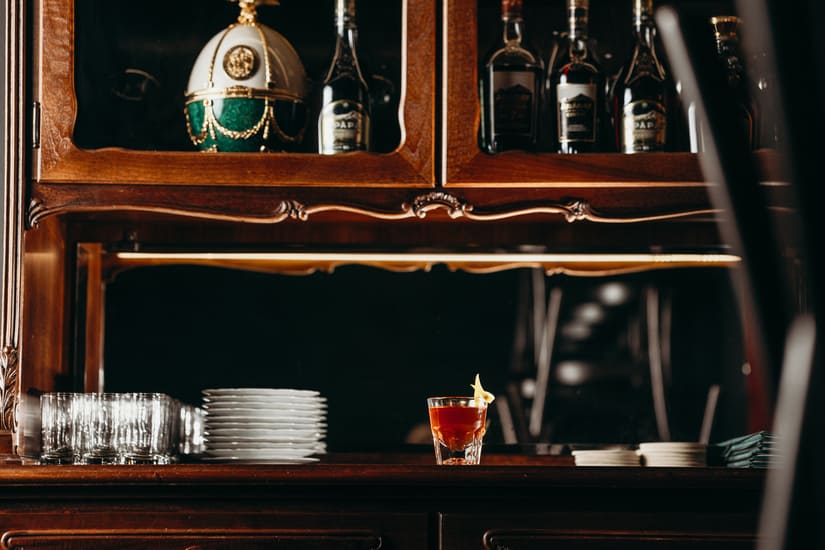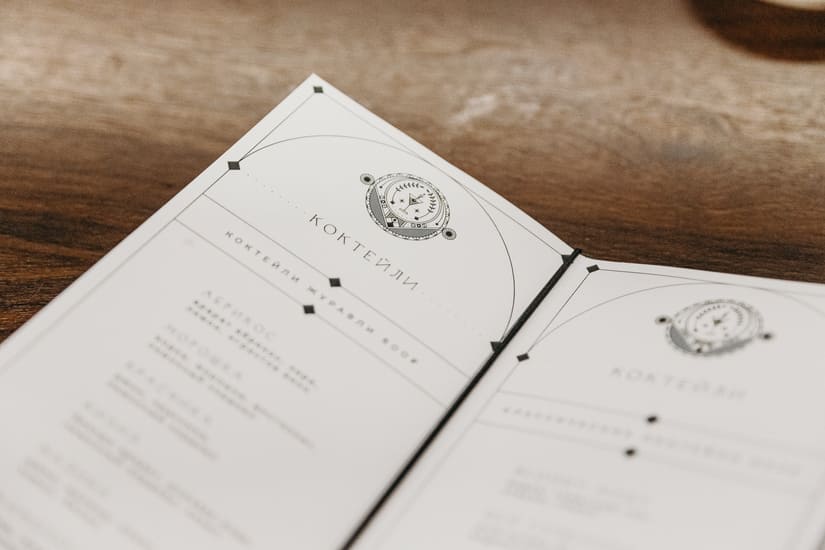- Today we are at the Zhuravli cocktail bar, and with us is the co-owner of this wonderful place - Pyotr Baryshnikov. Please tell us a little about yourself, the concept and general style of the bar.

- I am a co-owner and, so to speak, ideologist of this bar, and I also come up with all the cocktails together with the team. The idea of a bar, or rather the idea of opening a Russian bar, did not come to me, it was suggested by Vladimir Zhuravlev.
This is our Russian barchivarius - he knows everything about the concepts of establishments, not only Russian, but world-wide too. I learned a lot of information about cocktails from him: for example, about the history of cocktails. And I learned a lot from him about glass: about the names of certain glasses, for example.
Accordingly, he suggested that it would be nice to name the bar “Cranes” in honor of the proverb that Gilyarovsky reflected in his book “Moscow and Muscovites”, who, by the way, lived in the house opposite for a long time.
- Really?
- And on the contrary, yes, there is also a monument to Gilyarovsky and the center of Gilyarovsky... he was a local historian, a historian of Moscow, vividly described all sorts of signs of the times...
There was a proverb: “Drink until the cranes.” This meant that breakfast began in the Slavic Bazaar, the Slavic Bazaar is the first Russian restaurant opened by Russian people, not the French, in tsarist times. Before that there were only taverns and all sorts of taverns. So, breakfast began in the Slavic Bazaar and ended late... and people who knew and understood demanded “Cranes” (cognac) at the end. This is not an exact quote, but that's the idea. What did this mean? This cognac cost a lot of money - 50 rubles... accordingly, this is the same as ordering vintage champagne now... it is not surprising that many people collected these cognac bottles, because in addition to the cost, they were also painted with cranes.
- Let me clarify now, are we talking about the 18th-19th centuries?
- The end of the 19th, yes
- We talked about what the Cranes demanded... in the morning
- Yes, they demanded “Cranes”... but not in the morning. Breakfast began - this is an analogy of brunch in tsarist times. The cognac producer was Shustov, who at that time was a monopolist, so to speak, of alcohol, he had many factories throughout the Russian Empire. One of them is still preserved in Odessa, one was in Armenia. The one that was in Armenia now belongs to Pernod Ricard and the Armenian government - this is the Ararat brand. You can also find this descendant of the “Cranes” in our cocktails. That's the concept.
In fact, there is a lot more there... For example, the Slavic Bazaar itself. The restaurant originally got its name from the idea of creating a bazaar where people could come and sell their goods without resellers.
But nothing worked out, so they decided to open a restaurant instead of the bazaar, but kept the name. We also use part of this idea in our bar, and in every cocktail we use some kind of Russian ingredient, one or another. We are looking for them all over the country: from Karelia to the Far East. Here you can find cloudberries, a northern berry, and, for example, redberry, a berry that can only be found on Sakhalin.

- Well, we’ve just come to the issue of discussing cocktails. Your cocktail list is updated literally every month, and the drinks change. Surely this is very difficult and time-consuming. Please tell us how you approach the creation of a cocktail menu, and what influences it?
- In fact, we already have, so to speak, established cocktails, and we have a separate menu with classic cocktails. There is also a seasonal offer: about six cocktails, which we update monthly.
In fact, there is nothing complicated. By and large, seasonality, on the contrary, simplifies the task. Because you know for sure that every month you have certain products - berries, fruits, vegetables, herbs - in season. And, accordingly, we, using our experience in working in a bar, understand that there are a huge number of variations: fizzy drinks, sours... whatever. Based on this, we can easily come up with new cocktails with some seasonal ingredient. So the seasonal offerings are not something completely new, but a different interpretation of the classics with our local, seasonal ingredients.
- Well, many people don’t know what month is in our season. It’s September now, October will soon be, what are the seasonal berries and fruits in these months?
- Well, in September, firstly, it is rowan, as we know from the famous song... In September you can also use some mushrooms, you can find some watermelons. Persimmon, for example, is coming now. Soon there will be a pomegranatedecent, and then feijoa, for example. It is also necessary to separate both seasonal and local. That is, if it is seasonal, this is what we can find on the territory of the Russian Federation, or what is brought to us from our friendly countries - from Uzbekistan, from somewhere else, from Abkhazia, for example...
- Well, that is, the CIS countries?
- CIS, yes, including.
- But in winter? In winter everything is covered in snow, what is the seasonality in winter?
- In winter, yes, there is no season as such. But here our Russian experience of procurement and conservation comes to us. Sometimes we even prepare something for the winter, sometimes we use something already prepared by someone else.

- Tell us a little about the wine list? You present a large number of Russian wines. It’s interesting to know: what do you think about winemaking in Russia, what are the possible prospects for Russian wines, and how interesting is this in general for a bar located in the center of Moscow.
- I believe that the prospects have been evident for a long time. And anyone who doesn’t understand this yet is short-sighted. Many already know that there are all sorts of ratings like: the top 50 best bars, the top 50 best restaurants... But since 1919, there has also been a rating of the top 50 best wineries. There is also a top 100. For example, the winery from Anapa, Gai-Kodzor, is now in 80th place among the best wineries.
And yesterday we announced the list of the top 50, which included two more Russian wineries: the Lefkadia Valley, Krasnodar region, and the Sikora Valley. Here you go - this is already global recognition of Russian winemaking. In fact, you can find a lot of decent Russian wines, and in a blind tasting they easily outperform their European counterparts.
- Do you have any favorite Russian wine?
- In fact... we have gathered all the top representatives, by the way, with the exception of Gai-Kodzor. We have both Lefkadia and the Sikora Valley... we have the manufacturer “Galician and Galician”. I also like Fanagoria. Fanagoria is notable for the fact that it makes decent petnuts - natural wines with residual fermentation. After fermentation, of course, Russian grapes reveal themselves in a fantastic way. Krasnostop, for example.
- Well, now we come to an interesting question: what are the main criteria when choosing dishes?
- We have a chandelier in the interior, but in fact it doesn’t resonate much in cocktails and glasses... our glasses are quite minimalistic. Not some fantastic Bohemian crystal or something like that... Firstly, we serve cocktails in the glasses in which they should be served. I am always responsible for the glasses. In general, I love collecting different forms. Here's the Sazerac we made today, it's a little smaller than the Sazerac they make in New Orleans, but the shape of the glass is the same. You can say that we cook in authentic glasses.

- That is, a classic form, a classic presentation, only with a peculiar touch?
- Yes, with our touch, let’s say so.
- How difficult is it to find classic shapes of classic glasses?
- Thank God, now the trend is such that people are recreating the shapes of exactly those glasses that they saw in films of the 30s, for example. This is how the shape of the Nick&Nora glass appeared, which is now very popular. But initially it was smaller.
An American woman, Audrey Sanders, decided to recreate this glass shape in honor of the characters in the film “The Thin Man,” whose names were Nick and Nora. In this series of films, this couple constantly drinks from just such glasses. We can say that everything returns to the classics. The dark era of mixed drinks and everything incomprehensible has long passed. And in Russia too, thank God. Not in all regions, but still.
- When you created your bar, was there a desire to serve something in a classic way?
- There was a desire, and there is always one, to serve everything in a classic way. Okay, bartenders and establishment owners are interested, but the consumer is usually not familiar with anything: neither the drinking culture, nor the traditions, nor the shapes of glasses. Because there was nothing of this in Russia: everything was invented in America, then migrated to Europe, Cuba and somewhere else. This was everywhere, if we talk about large countries, but in Russia it was not, because we had a cut glass and a shot glass. I think it would be good to study and know the history of glasses, and maybe somehow convey this information to guests, because our aesthetics and drinking culture are a little different.
- Do you have a favorite drink, cocktail that was, is or will be on the menu at “Zhuravli”?
- Yes, we have two flagship cocktails. Actually more, but the most popular are,just like “Cloudberry”. We make it from moonshine, Russian distillate, vodka infused with cloudberries, and a little lemon. This is a sweet and sour cocktail with a pronounced cloudberry flavor. And the second one is “Krasnika”. She was actually a revelation last year for me.
- Why?
- Sergei Chesnokov from the Strelka bar opened it for me. Probably, firstly, because I have never seen her. Secondly, because it has a unique taste. Its chemical composition is something like benzene, and it unfolds differently for each guest. Some people think there are cashews, some think it’s gasoline, some think it’s wet asphalt. It evokes a huge range of emotions. A very cool thing, and it is not common in Russia at all.
- What kind of berry is this?
- Sakhalin, Far Eastern. In English it is called Sakhalin berry. That is, it does not have an original English name, only a Latin one. And people call it “klopovka”.
- What are the cocktails you like served in?
- These are all sweet and sour cocktails, gimlets, in a glass with a stem. Libbey, of course.
- This is not my first time visiting you, and last time you had a very large group of foreigners visiting you. Surely many people want to bring a foreign friend here to show him a piece of Russian culture. How often do you have foreign guests, and what do they order?
- Not so often with the pandemic, but they exist. Basically, for some reason, everyone drinks Bloody Mary and at the same time we show all our Russian liqueurs, rare ingredients, everyone is surprised. There would be more of them, of course...
- Where do you, as a menu and drink creator, get inspiration from, and how can a modern bar stay on trend?
- I once was at a Paul Smith exhibition in London, and he had a picture or inscription on the wall that I remembered. In a rough translation it was written: “Inspiration can be found anywhere.” That's all! I used to try to find inspiration in old recipes, in general, only in bar history. And then I began, so to speak, to look in all directions. You can take a lot from art, from the world of cuisine; some bartenders, unfortunately, do not interact so closely with the kitchen. In general, any idea can be projected onto cocktails.

- How not to ignore modern trends?
- It is necessary to remain aware and not follow what is fashionable now, using experience and understanding of the process. Of course, you don’t need to make only whiskey and cola all the time, you need to know what people are drinking now and focus on the consumer. It’s just that sometimes blindly following trends turns into a spineless story. We can, of course, say that we need to focus on well-known publications and what is happening in the world, but often this is not applicable to Russia. Even if we do it like in Europe, there is a big risk that the guest will not understand, he won’t need it.
There was, of course, a crazy boom when everyone went to Italy and drank Aperol Spritz in Moscow, but now no one goes anywhere. Therefore, it’s good to create something of your own, like us. There are very few Russian bars in Russia: there is the Orthodox bar in St. Petersburg, we are in Moscow, but there is nothing else like that. There are Mexican bars, American bars and others like them. There are many worthy domestic producers, but they remain unnoticed by bars. And in vain. I would like the trend to remain in the modern Russian focus, to rethink Russian local ingredients, or use them in a new way, and not use this unfortunate passion fruit endlessly. Identity trend, these are good succinct words, it seems to me.
















































/https%3A%2F%2Fcomplexbar.com%2Fimages%2Fblog%2F58%2Fbarysh-1024x1024.jpeg)
/https%3A%2F%2Fcomplexbar.com%2Fimages%2Fblog%2F246%2Fsirop_scale_2400.jpeg)
/https%3A%2F%2Fcomplexbar.com%2Fimages%2Fblog%2F246%2Fkofe-vostochniy.jpg)
/https%3A%2F%2Fcomplexbar.com%2Fimages%2Fblog%2F245%2Fpexels-jason-villanueva-851555.jpg)
/https%3A%2F%2Fcomplexbar.com%2Fimages%2Fblog%2F246%2F2024-04-09_17.22.54.jpg)
/https%3A%2F%2Fcomplexbar.com%2Fimages%2Fblog%2F246%2F2024-04-09_17.22.47.jpg)
/https%3A%2F%2Fcomplexbar.com%2Fimages%2Fblog%2F246%2FCODE_anons_foamydrops_752%D1%85480_eng.jpg)
/https%3A%2F%2Fcomplexbar.com%2Fimages%2Fblog%2F246%2FAlina_752%D1%85480_eng.jpg)
/https%3A%2F%2Fcomplexbar.com%2Fimages%2Fblog%2F246%2F2024-04-09_17.23.22.jpg)
/https%3A%2F%2Fcomplexbar.com%2Fimages%2Fblog%2F246%2F2024-04-09_17.23.28.jpg)
/https%3A%2F%2Fcomplexbar.com%2Fimages%2Fblog%2F246%2F2024-04-09_17.23.35.jpg)
/https%3A%2F%2Fcomplexbar.com%2Fimages%2Fblog%2F246%2Fdrinksome_752%D1%85480_eng.jpg)
/https%3A%2F%2Fcomplexbar.com%2Fimages%2Fblog%2F246%2Fnude_752%D1%85480_eng.jpg)
/https%3A%2F%2Fcomplexbar.com%2Fimages%2Fblog%2F246%2F752%D1%85480_eng__1_.jpg)
/https%3A%2F%2Fcomplexbar.com%2Fimages%2Fblog%2F246%2F752%D1%85480_eng.jpg)
/https%3A%2F%2Fcomplexbar.com%2Fimages%2Fblog%2F246%2FStudioRaw_752%D1%85480_eng.jpg)
/https%3A%2F%2Fcomplexbar.com%2Fimages%2Fblog%2F246%2FDoppio_tea_752%D1%85480_eng.jpg)
/https%3A%2F%2Fcomplexbar.com%2Fimages%2Fblog%2F246%2FTognana_Stars_Stripes_752%D1%85480_eng.jpg)
/https%3A%2F%2Fcomplexbar.com%2Fimages%2Fblog%2F246%2FRona_752%D1%85480_eng.jpg)
/https%3A%2F%2Fcomplexbar.com%2Fimages%2Fblog%2F246%2FDoppio_vending_752%D1%85480_eng.jpg)
/https%3A%2F%2Fcomplexbar.com%2Fimages%2Fblog%2F246%2FEssence_sukhie_smesi_752%D1%85480_eng.jpg)
/https%3A%2F%2Fcomplexbar.com%2Fimages%2Fblog%2F246%2FODK_sukhie_smesi752%D1%85480_eng.jpg)
/https%3A%2F%2Fcomplexbar.com%2Fimages%2Fblog%2F246%2Funiforma-barmena.jpg)
/https%3A%2F%2Fcomplexbar.com%2Fimages%2Fblog%2F246%2Fkak-nanyat-barmena.jpg)
/https%3A%2F%2Fcomplexbar.com%2Fimages%2Fblog%2F246%2Fsirop_scale_2400.jpeg)
/https%3A%2F%2Fcomplexbar.com%2Fimages%2Fblog%2F246%2FPeugeot_Anons_Paris_U%27Select_Line_Daman_752%D1%85480_eng.jpg)
/https%3A%2F%2Fcomplexbar.com%2Fimages%2Fblog%2F246%2Fkofe-vostochniy.jpg)
/https%3A%2F%2Fcomplexbar.com%2Fimages%2Fblog%2F246%2FMadler.jpg)
/https%3A%2F%2Fcomplexbar.com%2Fimages%2Fblog%2F246%2Fprofbartender_glavn.jpeg)